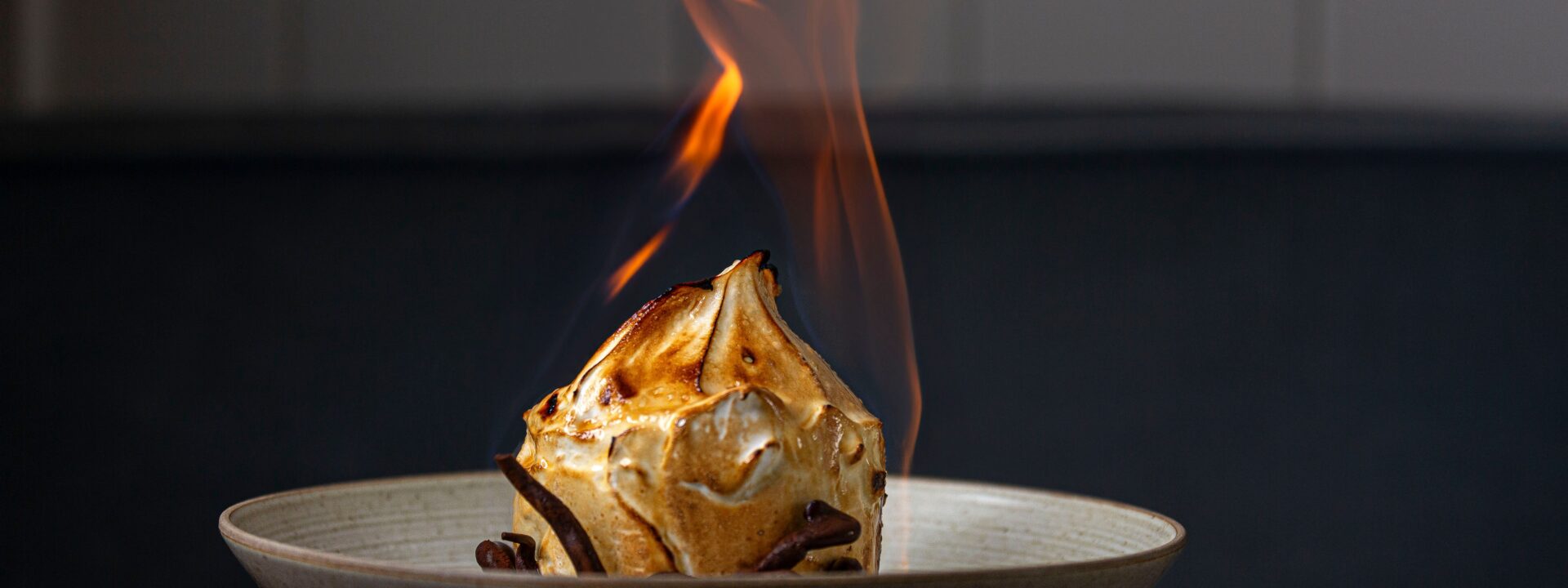What’s both fiery and icy at the same time? The baked Alaska—a dessert where toasted meringue protects ice cream and cake from an open flame—naturally. And right now, this classic dish is making a comeback.
Until recently, much like hot pink Motorola Razrs or Juicy Couture tracksuits, the baked Alaska was one of those nostalgic things people remembered but couldn’t quite place. Yet it makes sense that a dessert once tied to the bold extravagance of the Gilded Age would find new popularity in today’s era of gold-flecked, caviar-topped soft serve and martinis priced like full meals.
The original baked Alaska dates back to 1876, when chef Charles Ranhofer of New York’s Delmonico’s served a version with banana ice cream and walnut spice cake, initially calling it “Alaska, Florida.” It was likely inspired by the French omelette Norvégienne—ice cream and sponge cake encased in meringue—and named to celebrate the U.S. acquisition of Alaska.
For decades, the dessert remained a staple at upscale restaurants. “It was the Champagne of desserts,” says Laura Shapiro, author of What She Ate: Six Remarkable Women and the Food That Tells Their Stories, referring to its exclusive appeal. Until the 1940s, you were more likely to order it at a steakhouse than attempt making it at home. But with the rise of electric broilers, boxed cake mixes, and home freezers in the 1950s, it became a showstopping dinner party finale.
By the late 1970s, its popularity faded as tastes shifted toward sleeker, simpler styles. Yet in recent years, chefs and bakers have revived its playful drama. It’s reappeared in Mad Men, been called the “ultimate gay food,” and even credited as a nun’s secret to long life. Today, a new wave of chefs is reinventing it with seasonal twists and cultural influences, turning the quirky dessert into a full-fledged trend.
One standout version comes from Brooklyn’s historic Gage & Tollner, where former pastry chef Caroline Schiff introduced a modern take in 2018: fluffy meringue encasing Amarena cherry, fresh mint, and dark chocolate ice cream over chocolate cookie crumbs. Priced at $24, it’s meant for two but easily serves four. “Trends come and go,” Schiff said. “I see Gen Z wearing clothes from my high school days—it’s the same idea.”
In Seattle, chef Johnny Courtney of Atoma crafted a seasonal baked Alaska with roasted parsnip ice cream, tarragon meringue, and carrot cake when the restaurant opened in 2023. The dish evolves with the seasons—this summer featured a cherries Jubilee-inspired version with brandied fruit, malted vanilla ice cream, and rum cake. Courtney’s favorite so far? A corn variation with earthy corn ice cream and corn husk-infused meringue. Next year, he plans a nostalgic twist on gas station strawberry shortcake bars.
Further south in Carlsbad, California, Campfire’s wood-burning hearth infuses its entire menu—including the baked Alaska—with smoky depth. Their version features smoked vanilla gelato over rye cake, coffee meringue, and cassis, flambéed tableside with Grand Marnier. “It’s a showstopper,” says chef de cuisine Sergei Simonov. “People’s eyes light up when it arrives,” adds executive chef Eric Bost.
At Houston’s Bludorn, the Alaska mimics a campfire, with meringue peaks resembling flames hiding Speculoos ice cream and malted chocolate.
From its Gilded Age roots to today’s creative reinventions, the baked Alaska continues to dazzle—proving that some classics never truly go out of style.Baked Alaska is a playful dessert—an old-school classic that doesn’t take itself too seriously. Chef Aaron Bludorn’s dream version features huckleberries and cream cheese ice cream, served atop a graham cracker crust with chocolate sticks resembling firewood.
In Washington, D.C., pastry chef Paola Velez draws inspiration from the Caribbean for her Baked Alaska Frío Frío at Providencia. This twist on the Dominican shaved ice treat layers strawberries, matcha, nata de coco, and fruit syrups between delicate ice, all encased in suspiro—a sturdy Dominican meringue. A María biscuit crowns the dessert, which rotates flavors like persimmon, banana, and cotton candy grapes.
San Diego’s Mister A’s has served baked Alaska since 1965, but pastry chef Amy Simpson keeps it fresh with seasonal variations. This summer’s version features a coconut macaroon base and housemade POG (passion fruit, orange, guava) sorbet. Elsewhere in San Diego, chefs get creative—Dante Romero offers a churro-inspired take with cinnamon and chocolate at Lion’s Share, while Gregory Gourget serves a Baked Haiti with coconut sponge cake and spiced pineapple Bavarian cream at Portland’s Kann.
Across the pond, London is embracing the trend too. At Firebird, the dessert gets a British twist with Victoria sponge and Earl Grey ice cream wrapped in Swiss meringue. Meanwhile, Happy Endings’ Terri Mercieca crafts the Love Bomb—a raspberry parfait with a passion fruit heart, coconut dacquoise, and freeze-dried raspberries.
Baked Alaska’s enduring appeal lies in its perfect trio: ice cream, cake, and toasted meringue. It’s a spectacle with substance, balancing nostalgia and practicality. In an era of rising costs, its shareable nature justifies higher price points—especially when flambéed.
While it dazzles on menus, it’s also approachable for home cooks. With store-bought ice cream and simple techniques, anyone can recreate the magic. As food writer Shapiro notes, the thrill of fire meeting ice never fades—making baked Alaska a dessert that will always captivate.
Whimsical, indulgent, and unapologetically extravagant, baked Alaska delivers a finale that never fails to impress.with applause.
